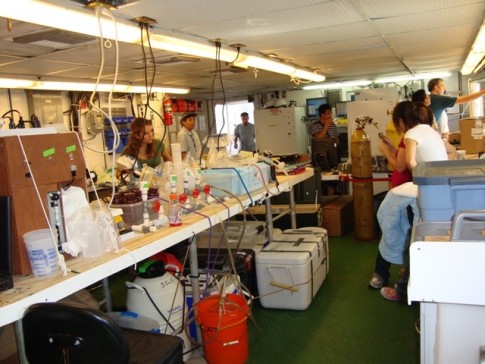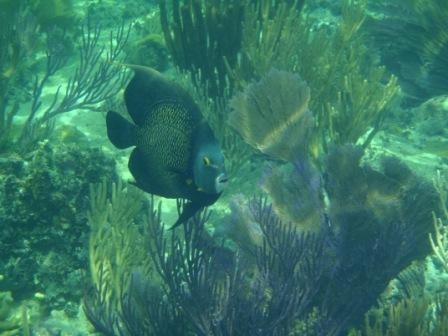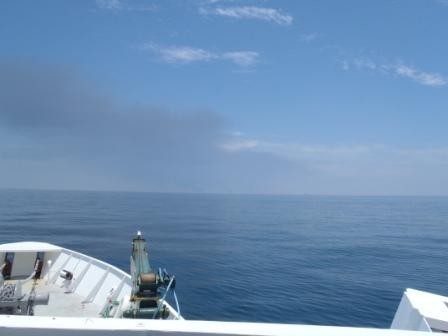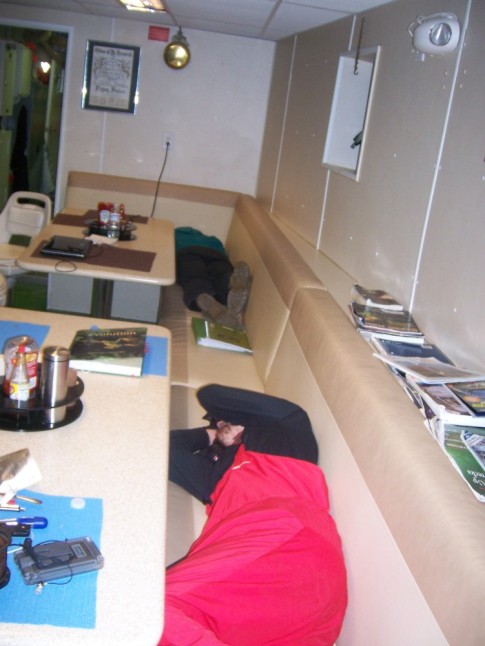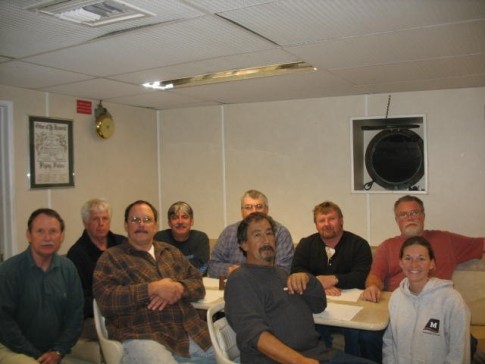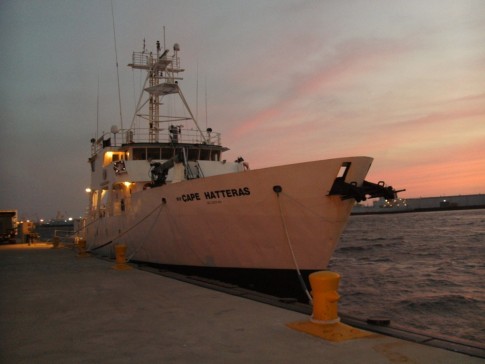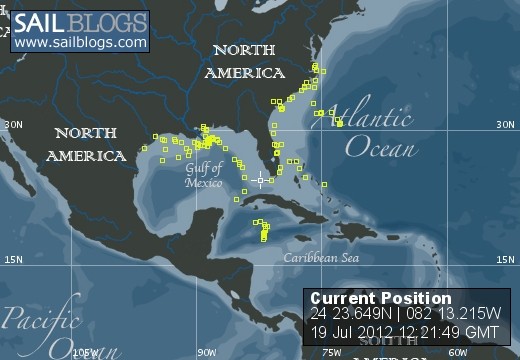
Research Vessel Cape Hatteras
The R/V CAPE HATTERAS is owned by the National Science Foundation and operated under a renewable Charter Party Agreement by the Duke/UNC Oceanographic Consortium. Her homeport is at Duke University Marine Laboratory in Beaufort, North Carolina.
11 March 2013
01 February 2013 | Beaufort, NC
14 January 2013
14 January 2013
19 July 2012 | Straits of Florida
19 July 2012
04 July 2012
15 November 2011 | East Flower Garden Banks, Gulf of Mexico
06 November 2011 | East Flower Garden Back, Gulf of Mexico
05 November 2011 | Gulf of Mexico
27 August 2011 | North Charleston, SC
26 August 2011 | North Charleston, SC
25 August 2011 | off SC coast
23 August 2011 | off the coast of NC
23 August 2011 | Off the coast of NC
06 August 2011 | Gulf of Mexico
05 August 2011 | GUlf of Mexico
30 June 2011 | Gulf of Mexico
30 June 2011 | Charleston, SC
25 May 2011 | Mission Annelid: Success
Day 2
20 May 2011 | Transect 1 - Cape Fear
Erik Brush
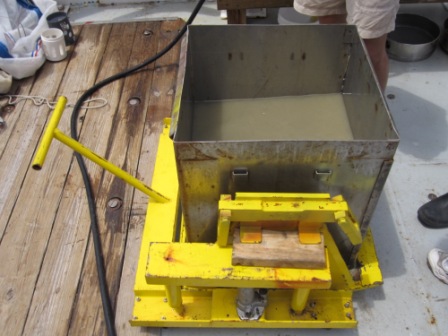
Journey to the Center of the...Err wait...20,000 Leagues Under the Sea...the box core that is, not us
Today we all woke up and were ready to conduct research at the crack of 6:30, which unbeknownst me is not before the sunrise. I went to bed last night fully expecting it to be dark when I woke up, but apparently the sun beat me to it. As your typical undergrad, I am not a morning person in any shape or form, and most of the graduate students and professors looked like a few hours more sleep would have been much appreciated, but instead we kicked back a few cups of coffee and got to work.
Our day started with a failed box core attempt. At our first station, the depth was only 500 meters and the bottom consisted of mostly sand, making it difficult for the equipment to pick up samples. We took a break for yet another awesome meal made by the cooks on board while another piece of equipment called a sled was dragged along the bottom to bring up sediment samples. This proved more efficient as it provided sand to sift through and remove all of the different annelid worms that the researchers on this vessel have been so eager to find.
With the first station completed, we moved on to the second where the box core worked much better at a depth of 800 meters, bringing up a good amount of mud and sand, through which we sifted for more organisms. However, we also conducted a C.T.D. (Conductivity and Temperature at Depth), which measures salinity, temperature, and depth while simultaneously taking water samples. It basically looks like a giant vertical cylinder with containers for water capture surrounding it that can be closed remotely.
We began heading for our next site, and the box core was loaded into the water once we got there. At a depth of 2000 meters, it takes the box core close to an hour and a half to go down and come back up. However, this proved to be another set back. When the box core came back up, the door failed to close all the way, allowing some of the mud to escape as the device was being raised back to the surface. In addition, the wire pulling it back up had become frayed, a danger to anyone near it as it was hanging above the ship. Lucky for us, the ship's crew was able to spring into action, cutting another piece of steel wire the correct length for use. Unfortunately, the box core malfunctioned again, failing to close all the way and disturbing the sample within. Dr. Schulze, the primary investigator on this cruise, decided to move on to the next site, which we will reach by morning. While it is unfortunate that we did not get a good sample of organisms from this site, I am feeling good about tomorrow. I think our luck will pick up with the use of the other box core device.
However, I must say that my favorite part of the cruise isn't during the day, but rather after hours when the work is done. After I have rinsed myself of all the mud from the bottom of the ocean, there is no experience like relaxing on the bow of the ship. The feeling of the ocean breeze across your face, the sight of the moon glimmering across the glassy surface of the ocean, and the sparkling of Noctiluca (a type of tiny plankton in the water) as there bioluminescence lights up the wake of the ship have a calming effect on me, almost spiritual in a way. It allows me to wind down before I return to my room below to be gently rocked to sleep by the sea like a baby.
Today we all woke up and were ready to conduct research at the crack of 6:30, which unbeknownst me is not before the sunrise. I went to bed last night fully expecting it to be dark when I woke up, but apparently the sun beat me to it. As your typical undergrad, I am not a morning person in any shape or form, and most of the graduate students and professors looked like a few hours more sleep would have been much appreciated, but instead we kicked back a few cups of coffee and got to work.
Our day started with a failed box core attempt. At our first station, the depth was only 500 meters and the bottom consisted of mostly sand, making it difficult for the equipment to pick up samples. We took a break for yet another awesome meal made by the cooks on board while another piece of equipment called a sled was dragged along the bottom to bring up sediment samples. This proved more efficient as it provided sand to sift through and remove all of the different annelid worms that the researchers on this vessel have been so eager to find.
With the first station completed, we moved on to the second where the box core worked much better at a depth of 800 meters, bringing up a good amount of mud and sand, through which we sifted for more organisms. However, we also conducted a C.T.D. (Conductivity and Temperature at Depth), which measures salinity, temperature, and depth while simultaneously taking water samples. It basically looks like a giant vertical cylinder with containers for water capture surrounding it that can be closed remotely.
We began heading for our next site, and the box core was loaded into the water once we got there. At a depth of 2000 meters, it takes the box core close to an hour and a half to go down and come back up. However, this proved to be another set back. When the box core came back up, the door failed to close all the way, allowing some of the mud to escape as the device was being raised back to the surface. In addition, the wire pulling it back up had become frayed, a danger to anyone near it as it was hanging above the ship. Lucky for us, the ship's crew was able to spring into action, cutting another piece of steel wire the correct length for use. Unfortunately, the box core malfunctioned again, failing to close all the way and disturbing the sample within. Dr. Schulze, the primary investigator on this cruise, decided to move on to the next site, which we will reach by morning. While it is unfortunate that we did not get a good sample of organisms from this site, I am feeling good about tomorrow. I think our luck will pick up with the use of the other box core device.
However, I must say that my favorite part of the cruise isn't during the day, but rather after hours when the work is done. After I have rinsed myself of all the mud from the bottom of the ocean, there is no experience like relaxing on the bow of the ship. The feeling of the ocean breeze across your face, the sight of the moon glimmering across the glassy surface of the ocean, and the sparkling of Noctiluca (a type of tiny plankton in the water) as there bioluminescence lights up the wake of the ship have a calming effect on me, almost spiritual in a way. It allows me to wind down before I return to my room below to be gently rocked to sleep by the sea like a baby.
Comments
| Vessel Name: | R/V Cape Hatteras |
| Hailing Port: | Beaufort, NC |
| Extra: | |
| Home Page: | www.rvcapehatteras.org |

Port: Beaufort, NC
